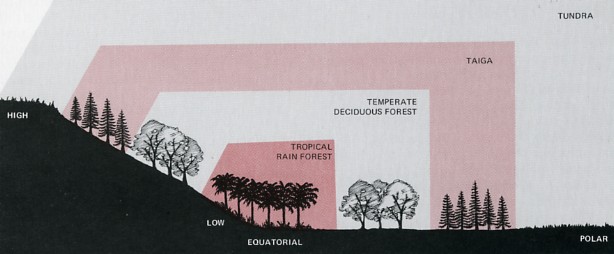In a previous soils lesson activity, you were asked to study and describe the relationship between soil distribution and latitude. Subsequently, in the climate lesson, you read about the distribution of different climates on Earth and the Koeppen climate classification system. Now I want you to briefly compare the relationship between biomes and climate using the Koeppen classification.

Activity
Directions
NOTE:
For this assignment, you will need to record your work on a word processing document. Your work must be submitted in Word (.doc) or PDF (.pdf) format so I can open it. In addition, documents must be double-spaced and typed in 12 point Times Roman font.
- Read about World Climates at the Blue Planet Biomes Web site.
- First, notice that climate is divided into three climate zones: low, mid, and high latitude. Consider the relationship between climate and biomes—think globally and be creative.
- If you need to look at the global biome distribution maps from the Raven chapter on page 2 of this lesson, do so.
- Gradually focus your attention toward the distribution maps for North America shown in Chapter 52 of Biology (refer back to Lesson 10, page 5). You should notice some pretty clear relationships, but also some disparities.
- To what do you attribute the disparities?
- Does the geomorphologic character displayed in the very generalized landscape map of North America provide answers?
- Compare your observations and conclusions to the global soil distribution map. Are there any general conclusions you can make?
- Once you have a clear sense for these global-scale relationships, focus on your study site.
- How do sweeping generalizations like those made above apply to your study site?
- Are the regional-scale observations you have made thus far through this course consistent with these generalizations?
- Consider using the BiomeViewer.
- Record your responses to questions posed in 4 and 5 above as the start of a three-page report that you will continue working on later in this lesson.
- Save your report as either a Microsoft Word or PDF file in the following format:
L11_biomes_AccessAccountID_LastName.doc (or .pdf).
For example, student Elvis Aaron Presley's file would be named "L11_biomes _eap1_presley.doc"—this naming convention is important, as it will help me make sure I match each submission up with the right student!
- Continue with this lesson.